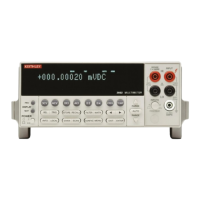IEEE-488 Reference
3-93
:APERture <n>
[:SENSe[1]]:CURRent:AC:APERture <n> Set aperture for ACI
[:SENSe[1]]:CURRent:DC:APERture <n> Set aperture for DCI
[:SENSe[1]]:VOLTage:AC:APERture <n> Set aperture for ACV
[:SENSe[1]]:VOLTage:DC:APERture <n> Set aperture for DCV
[:SENSe[1]]:RESistance:APERture <n> Set aperture for Ω2
[:SENSe[1]]:FRESistance:APERture <n> Set aperture for Ω4
[:SENSe[1]]:TEMPerature:APERture <n> Set aperture for TEMP
<n> = 166.6666666667e-6 to 1 Integration period in seconds
DEFault Power line cycle integration:
16.67msec for 60Hz power line
20msec for 50Hz and 400Hz power line
MINimum 166.6666666667e-6sec
MAXimum 1sec
:APERture? Query programmed aperture value.
:APERture? DEFault Query *RST default aperture value.
:APERture? MINimum Query minimum aperture value.
:APERture? MAXimum Query maximum aperture value.
The integration period (measurement speed) for the Model 2002 can be set using either of two
commands; NPLCycle (paragraph 3.18.6) or :APERture. The NPLC method specifies the inte-
gration period as the number of power line cycles per integration, while aperture specifies the
time (in seconds) per integration. Refer to paragraph 2.4 for details on integration (SPEED). The
relationship between NPLC and aperture is expressed as follows:
where; Aperture is the integration rate in seconds per integration.
NPLC is the number of power line cycles per integration.
f is the power line frequency. (Note: For 400Hz line power, use 50Hz to calculate
aperture).
When the integration period is set using the :APERture command, the value for the :NPLCycle
command changes accordingly to reflect the new integration period. Conversely, if the integra-
tion period is set using the :NPLCycle command, the value for the :APERture command
changes accordingly.
On power-up, the instrument uses the NPLC value to determine the integration period. Thus, if
using a different power line frequency, NPLC will remain the same, but aperture may change.
Note: If line synchronization is enabled (see:LSYNc command in SYSTem subsystem), the
integration period will not start until the beginning of the next power line cycle. For example, if
a reading is triggered at the positive peak of a power line cycle, the integration period will not
start until that power line cycle is completed. The integration period starts when the positive-
going sine wave crosses zero volts. See paragraph 2.12.7 for more details.
PRINT #1, "output 16; :curr:ac:aper 16.67e-3; aper?" ' Select aperture for ACI
PRINT #1, "enter 16" ' Get response from 2002
3.18.5
Parameters
Query
Description
Aperture
NPLC
f
---------------=
Program fragment

